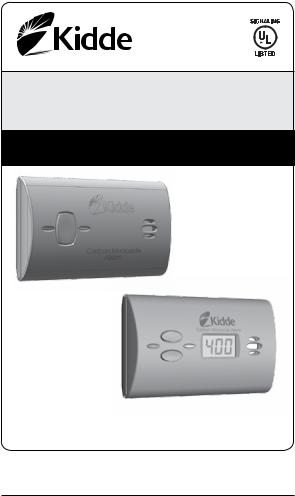Kidde KN-COPP-B-LPM, KN-COB-B-LPM User Manual

Carbon Monoxide Alarm
User’s Guide
Models: KN-COB-B-LPM and
KN-COPP-B-LPM (with Digital Display)
KN-COB-B-LPM
KN-COPP-B-LPM with Digital Display
•Digital Display
•Peak Level Memory
•3-AA Battery Operation
ATTENTION: Please take a few minutes to thoroughly read this user’s guide which should be saved for future reference and passed on to any subsequent owner.
Manual P/N 21008094 Rev. A 8/10

What to do When the Alarm Sounds!
Carbon Monoxide Alarm Procedure
 WARNING: Activation of the CO Alarm indicates the presence of Carbon Monoxide (CO) which can kill you.
WARNING: Activation of the CO Alarm indicates the presence of Carbon Monoxide (CO) which can kill you.
1)Operate the Test/Reset button;
2)Call your emergency services (Fire Department or 911);
PHONE NUMBER:
3)Immediately move to fresh air - outdoors or by an open door/ window. Do a head count to check that all persons are accounted for. Do not reenter the premises nor move away from the open door/window until the emergency services responders have arrived, the premises have been aired out, and your alarm remains in its normal condition.
4)After following steps 1-3, if the alarm reactivates within a 24 hour period, repeat steps 1-3 and call a qualified appliance technician to investigate sources of CO from fuel burning equipment and appliances, and to inspect for proper operation of equipment.
PHONE NUMBER:
If problems are identified during this inspection, have the equipment serviced immediately. Note any combustion equipment not inspected by the technician and consult the manufacturer’s instructions, or contact the manufacturer’s directly for more information about CO safety and the equipment. Make sure that motor vehicles are not, or have not been, operating in a garage attached or adjacent to the residence.
Never restart the source of a CO problem until it has been corrected. Never ignore the sound of the alarm!
If the alarm is sounding, pressing the test/reset button will terminate the alarm. If the CO condition that caused the alert in the first place continues, the alarm will reactivate. If the unit alarms again within six minutes, it is sensing high levels of CO which can quickly become a dangerous situation.
Welcome
Note: Many times throughout this User’s Guide, we will refer to Carbon Monoxide as “CO”.
This Kidde carbon monoxide (CO) alarm is an important part of your family’s home safety plan. This alarm has been designed and tested to detect CO buildup in a residential environment. Your alarm is for use specifically in the home. As an owner of a CO alarm, there are some basic facts you should know about for your protection.
Many people think that CO alarms operate like smoke alarms. Like smoke alarms, CO alarms monitor the air in your home and sound a loud alarm to warn you of trouble. The way you respond to a CO alarm is quite different than a smoke alarm. That’s because a house fire and a CO problem are two distinctly different situations. If your smoke alarm were to alarm, you would quickly be able to judge the level of danger you were in with your senses. You can see and smell the smoke, feel the heat, see, and possibly hear the fire burning. You can also readily see
if your smoke alarm is alarming in a non-emergency situation. Because your sense of sight, smell, hearing and touch give you information, you can almost instantly judge what action to take if you hear your smoke alarm.
CO is an invisible, odorless, tasteless and non-irritating gas – completely undetectable to your senses. That’s why it is important to your safety that you have a CO alarm.
Important Warning Statements
IMPORTANT: This carbon monoxide alarm is designed to detect carbon monoxide from ANY source of combustion. It is NOT designed to detect smoke, fire, or any other gas.
WARNING: Carbon monoxide alarms are not smoke alarms. This carbon monoxide alarm is not a substitute for installing and maintaining an appropriate number of smoke alarms in your home.
This carbon monoxide alarm will not sense smoke, fire, or any poisonous gas other than carbon monoxide even though carbon monoxide can be generated by fire. For this reason you must install smoke alarms to provide early warning of fire and to protect you and your family from fire and its related hazards.
CAUTION: This alarm will only indicate the presence of carbon monoxide at the sensor. Carbon monoxide may be present in other areas.

Important Warning Statements
WARNING: This product is intended for use in ordinary indoor locations of family living units. It is not designed to measure compliance with Occupational Safety and Health Administration (OSHA), commercial or industrial standards. It is not suitable for installation in hazardous locations as defined in the National Electric Code.
The installation of this device should not be used as a substitute for proper installation, use and maintenance of fuel burning appliances, including appropriate ventilation and exhaust systems. It does not prevent CO from occurring, nor can it solve and existing CO problem.
WARNING: This device is designed to protect individuals from acute effects of carbon monoxide exposure. It may not fully safeguard individuals with specific medical conditions. If in doubt, consult a medical practitioner.
Individuals with medical problems may consider using warning devices which provide audible and visual signals for carbon monoxide concentrations under 30 PPM.
This carbon monoxide alarm requires a continuous supply of electrical power – it will not work without power. Models without battery backup will not operate during power failure.
This alarm has not been investigated for carbon monoxide detection below 70 PPM.
Contents of This User’s Guide
1.Information About Carbon Monoxide
2.Product Features and Specifications
3.Installation Locations
4.Installation Instructions
5.KN-COB-B-LPM Operating Characteristics
6.KN-COPP-B-LPM (with digital display) Operating Characteristics
7.Alarm Characteristics
8.Maintenance
9.Limited Warranty
1. Information About Carbon Monoxide
General Carbon Monoxide Information
Carbon monoxide is a colorless, odorless and tasteless poison gas that can be fatal when inhaled. CO inhibits the blood’s capacity to carry oxygen.
Periodically review this alarm manual and discuss your CO alarm emergency procedure with all the members of your family. Never ignore a CO alarm. A true alarm is an indication of potentially dangerous levels of CO. CO alarms are designed to alert you to the presence of CO before an emergency – before most people would experience symptoms of CO poisoning, giving you time to resolve the problem calmly.
Determine if anyone in the household is experiencing symptoms of CO poisoning. Many cases of reported CO poisoning indicate that while victims are aware they are not well, they become so disoriented they are unable to save themselves by either exiting the building or calling for assistance. Also, young children and household pets may be the first affected. You should take extra precautions to protect high-risk persons from CO exposure because they may experience ill effects from CO at levels that would not ordinarily affect a healthy adult.
Symptoms of CO Poisoning
The following common symptoms are related to CO poisoning and should be discussed with ALL members of the household.
Mild Exposure:
Slight headache, nausea, vomiting, fatigue (often described as “flu-like” symptoms).
Medium Exposure:
Severe throbbing headache, drowsiness, confusion, fast heart rate.
Extreme Exposure:
Unconsciousness, convulsions, cardio-respiratory failure, death.
If you experience even mild symptoms of CO poisoning, consult your doctor immediately!
